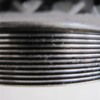I spoke to James about some of his issues and he thought it might me nice to post some of the details. There will be a few contrary points/observations to some of the information previously posted or brought forward by other experts. The information is a compilation of my personnel hands on experience, testing, logic, reading and talking to other experts about the issues in the following posts.
Most of the ZF work I have done has been rebuilding the input shaft gears and changing fifth ratios and it's no where near the other experts experience but I am extremely careful with each build and examine every re-installed component closely to make sure it will run correctly and if it is not good enough to re-install, I've always tried to discern why it failed in the first place. This has happened numerous times after removing worn out gear sets that are examined post mortem on how and why they failed. In an effort to find what was worn the worst, a new synchro was installed on the bad gear measuring the end clearance and then the worn out synchro was installed on a new gear measuring the end clearance. What I have found on every type 2 checked is that the old synchro will have far more clearance on a new gear than the new synchro will have on the old gear concluding that the cone was worn far more than the synchro so I decided to try and figure out the who-what-when-where-and most importantly why.
Spent quite a bit of time researching synchro history and designs and found some interesting details about how they work and the different manufacturing methods being used.
Getting into specific type 2 ZF synchro issues you have to look and the design being used the why it changed from the type 1. It appears type 0 and 1 sychros were cast and machined with lube transfer grooves on the inside similar to the try 2 gear cone pictured below and the type 2 synchro was made from a high pressure powered iron method and then coated on the inside surface. You can make a sophisticated design this way and it's far less labor intensive than casting and machining a similar part---basically cheaper. The down side is you have to groove the receiving gear cone which it's sole purpose is to dissipate the lube so the synchro will speed up or slow down the gear enabling it to lock into the shift collar. Synchro/receiving collars have a non locking taper and as long as the lube will dissipate---and in the case of this design, hydrolic into the grooves the taper will do the work no mater what the surfaces finish's are. Now things are working in milla-seconds and as the surface changes, so will the speed and shift pressures required to make the gear slow or speed up. Remember the gears are actually moving in the opposite direction of the shift for a split second as the synchro aligns with the cone teeth and shift collar. This is a bit wordy and hard to explain by typing so let me get to the hart of the issue.
There are several problems with worn gear cones, one being the wear pattern is unfortunately not flat so a new synchro will not engage the entire surface---they may shift fine but will wear faster cutting it to the same taper as the old worn gear cone. This is not a big difference but you can clearly see the problem when you put a new synchro on the old gear cone and it rocks. This does not always happed so you can install new synchros on old gears so long as the clearance is adequate. Second---as the grooves wear down, the lube can not dispatch as fast allowing the synchro to grab the gear--remember this happens in fractions of the second. Also the groove tops will mash a bit and splay into the groove opening closing off the area a bit more. Think of it as tire tread moving water---if half the trade is missing and the rubber has mashed sideways from a long burn out closing off the grove a bit more, the tire can not more the water from the surface---just like lube on the cones.
In short by studying the problem extensively---IMHO---, cones on the type 2 gears wear much faster than the synchros because there is half the surface receiving the synchro's inside scrub surface. Now I have not tested the hardness of either component but will show you the wear results and the newer design up-grades.
I will start with the close-up of a damaged shift cone. Take notice of the left to right ware pattern---left rings are worn much more than the right rings---look at the width difference of the ring surfaces. If you were to install a new synchro on this cone, it would rock and primarily drag on the right side groove rings. If there was adequate clearance between teeth surfaces, (.030 would be great but with this much damage even a new synchro might have only .010) the new synchro will wear out much faster from not having a good surface match from previous wear damage and only work properly for a shot time.
PANTERA INTERNATIONAL
A DE TOMASO CAR CLUB
Presents the De Tomaso Forums
The On-Line Meeting Place for De Tomaso Owners and Enthusiasts From Around the World
Clicking on the banner will take you to the sponsor's website.


